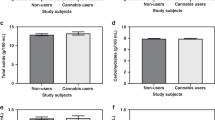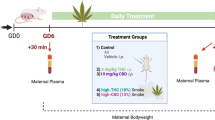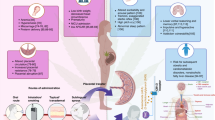Abstract
Background
Information on cannabinoids in breast milk and maternal cannabis use is limited. We quantified cannabinoids in plasma and breast milk of breastfeeding mothers and assessed cannabis use patterns.
Methods
This is a prospective study at a university hospital in a state with legal medical and recreational cannabis. Breast milk and plasma samples along with survey data were collected from volunteers using cannabis in the last 48 h at 2 weeks and 2 months postpartum.
Results
Twenty subjects were enrolled. Median age (IQR) was 27 (24–34) years. Median (IQR) instances of cannabis use in the last 7 days were visit 1: 17 (6–29) and visit 2: 23 (15–45). Median (IQR) tetrahydrocannabinol (THC) concentrations were: plasma 3.7 ng/ml (0.8–56.8) and breast milk 27.5 ng/ml (0.8–190.5). Median (IQR) cannabidiol (CBD) concentrations were: plasma 0.6 ng/ml (0.5–6.4) and breast milk 1.2 ng/ml (0.5–17.0). Median (IQR) THC M/P: 7.0 (1.8–34.6) and CBD M/P: 2.6. Median breast milk THC concentration increased from visit 1 to visit 2 by 30.2 ng/ml (95% CI 3.05–69.3 ng/ml).
Conclusions
THC and CBD accumulate in breast milk. Breastfeeding mothers used cannabis frequently and increased use in the early postpartum period. Research on the effects of infant exposure to cannabinoids in breast milk is urgently needed.
Impact
-
Cannabis use is increasing in the general population and many nursing mothers use cannabis.
-
THC has been previously detected in breast milk but little is known on how it concentrates relative to plasma. Data on cannabinoids other than THC, reasons for cannabis use, and patterns of use in breastfeeding women are also limited.
-
We detected THC and CBD in breast milk. Both concentrate in breast milk relative to plasma.
-
We showed that breastfeeding mothers increased cannabis use in the weeks after childbirth.
-
Further research is needed to evaluate infant exposure to cannabinoids via breast milk and effects on infant health.
Similar content being viewed by others
Log in or create a free account to read this content
Gain free access to this article, as well as selected content from this journal and more on nature.com
or
References
World Health Organization. The optimal duration of exclusive breastfeeding: report of the expert consultation https://www.who.int/nutrition/publications/infantfeeding/WHO_NHD_01.09/en/ (2001).
American Academy of Pediatrics. Breastfeeding and the use of human milk. Pediatrics 129, e827–e841 (2012).
Metz, T. D. & Stickrath, E. H. Marijuana use in pregnancy and lactation: a review of the evidence. Am. J. Obstet. Gynecol. 213, 761–778 (2015).
Young-Wolff, K. C. et al. Self-reported daily, weekly, and monthly cannabis use among women before and during pregnancy. JAMA Netw. Open 2, e196471 (2019).
Centers for Disease Control. Is it safe for mothers who use marijuana to breastfeed? https://www.cdc.gov/breastfeeding/breastfeeding-special-circumstances/vaccinations-medications-drugs/marijuana.html (2020).
General US. U.S. Surgeon General’s Advisory: Marijuana Use and the Developing Brain. https://www.hhs.gov/surgeongeneral/reports-and-publications/addiction-and-substance-misuse/advisory-on-marijuana-use-and-developing-brain/index.html (2019).
US Food & Drug Administration. What you should know about using cannabis, including CBD, when pregnant or breastfeeding. https://www.fda.gov/consumers/consumer-updates/what-you-should-know-about-using-cannabis-including-cbd-when-pregnant-or-breastfeeding (2019).
Brown, Q. L. et al. Trends in marijuana use among pregnant and nonpregnant reproductive-aged women, 2002–2014. J. Am. Med. Assoc. 317, 207–209 (2017).
Crume, T. L. et al. Cannabis use during the perinatal period in a state with legalized recreational and medical marijuana: the association between maternal characteristics, breastfeeding patterns, and neonatal outcomes. J. Pediatr. 197, 90–96 (2018).
Jarlenski, M. et al. Media portrayal of prenatal and postpartum marijuana use in an era of scientific uncertainty. Drug Alcohol Depend. 187, 116–122 (2018).
Ko, J. Y. et al. Prevalence and patterns of marijuana use among pregnant and nonpregnant women of reproductive age. Obstet. Gynecol. 213, 201.e1–201.e10 (2015).
Baker, T. et al. Transfer of inhaled cannabis into human breast milk. Obstet. Gynecol. 131, 783–788 (2018).
Bertrand, K. A., Hanan, N. J., Honerkamp-Smith, G., Best, B. M. & Chambers, C. D. Marijuana use by breastfeeding mothers and cannabinoid concentrations in breast milk. Pediatrics 142, e20181076 (2018).
Perez-Reyes, M. & Wall, M. E. Presence of delta9-tetrahydrocannabinol in human milk. N. Engl. J. Med. 307, 819–820 (1982).
Marchei, E. et al. Simultaneous analysis of frequently used licit and illicit psychoactive drugs in breast milk by liquid chromatography tandem mass spectrometry. J. Pharmacol. Biomed. Anal. 55, 309–316 (2011).
De Oliveira Silveira, G. et al. Headspace solid-phase microextraction and gas chromatography− mass spectrometry for determination of cannabinoids in human breast milk. Forensic Toxicol. 35, 125–132 (2017).
Zhang, X., Danaceau, J. & Chambers, E. Quantitative Analysis of THC and Metabolites in Urine with a Simple, Fast and Clean Oasis PRiME HLB µElution Plate (Waters Corporation, 2015).
Oregon Health Authority. Marijuana Report: Marijuana Use, Attitudes and Health Effects in Oregon (Oregon Health Authority, 2016).
Grotenhermen, F. Pharmacokinetics and pharmacodynamics of cannabinoids. Clin. Pharmacokinet. 42, 327–360 (2003).
Huestis, M. A. Human cannabinoid pharmacokinetics. Chem. Biodivers. 4, 1770–1804 (2007).
Deiana, S. et al. Plasma and brain pharmacokinetic profile of cannabidiol (CBD), cannabidivarine (CBDV), Δ9-tetrahydrocannabivarin (THCV) and cannabigerol (CBG) in rats and mice following oral and intraperitoneal administration and CBD action on obsessive-compulsive behaviour. Psychopharmacology 219, 859–873 (2012).
Gaston, T. E. & Friedman, D. Pharmacology of cannabinoids in the treatment of epilepsy. Epilepsy Behav. 70, 313–318 (2017).
Huestis, M. A., Henningfield, J. E. & Cone, E. J. Blood cannabinoids. I. Absorption of THC and formation of 11-OH-THC and THCCOOH during and after smoking marijuana. J. Anal. Toxicol. 16, 276–282 (1992).
Reboussin, B. A. et al. Trends in marijuana edible consumption and perceptions of harm in a cohort of young adults. Drug Alcohol Depend. 205, 107660 (2019).
Acknowledgements
We would like to thank Kevin Ng, BA, Alicia Johnson, MPH, and Jodi Lapidus, PhD with the Oregon Health & Science University Biostatistics & Design Program (partially supported by University Shared Resources and the Oregon Clinical and Translational Research Institute UL1TR002369 [OHSU CTSA]) for study design support and data analysis expertise. This study was partially supported by an Oregon Health & Sciences University Shared Resources Pilot grant award. Analytical work was conducted in the Bioanalytical Shared Resource/Pharmacokinetics Core. The facility is supported by the University Shared Resource Program at Oregon Health and Sciences University.
Author information
Authors and Affiliations
Contributions
All authors contributed to study design and conception, data analysis and interpretation, manuscript drafting, and gave final approval to the manuscript.
Corresponding author
Ethics declarations
Competing interests
The authors declare no competing interests.
Consent statement
Patient consent was required and obtained for study participants.
Additional information
Publisher’s note Springer Nature remains neutral with regard to jurisdictional claims in published maps and institutional affiliations.
Rights and permissions
About this article
Cite this article
Moss, M.J., Bushlin, I., Kazmierczak, S. et al. Cannabis use and measurement of cannabinoids in plasma and breast milk of breastfeeding mothers. Pediatr Res 90, 861–868 (2021). https://doi.org/10.1038/s41390-020-01332-2
Received:
Revised:
Accepted:
Published:
Issue date:
DOI: https://doi.org/10.1038/s41390-020-01332-2
This article is cited by
-
The changing landscape of cannabis use: impact on maternal health and neonatal outcomes
Pediatric Research (2025)
-
Sex-specific disruptions in the developmental trajectory of anxiety-like behaviors due to prenatal cannabidiol exposure
Translational Psychiatry (2025)
-
Cannabis use, decision making, and perceptions of risk among breastfeeding individuals: the Lactation and Cannabis (LAC) Study
Journal of Cannabis Research (2024)
-
Cannabinoids for treating psychiatric disorders in youth: a systematic review of randomized controlled trials
Child and Adolescent Psychiatry and Mental Health (2024)
-
Cannabis use during lactation may alter the composition of human breast milk
Pediatric Research (2023)



